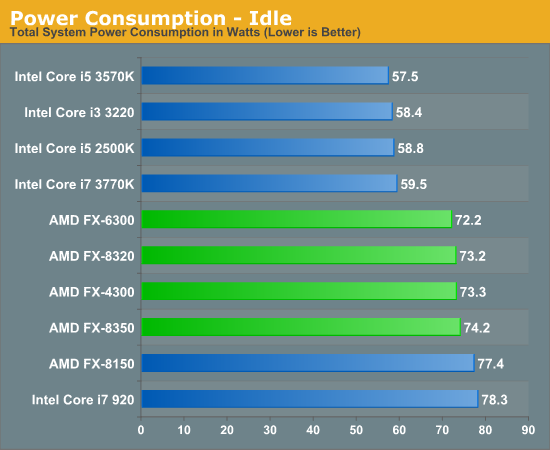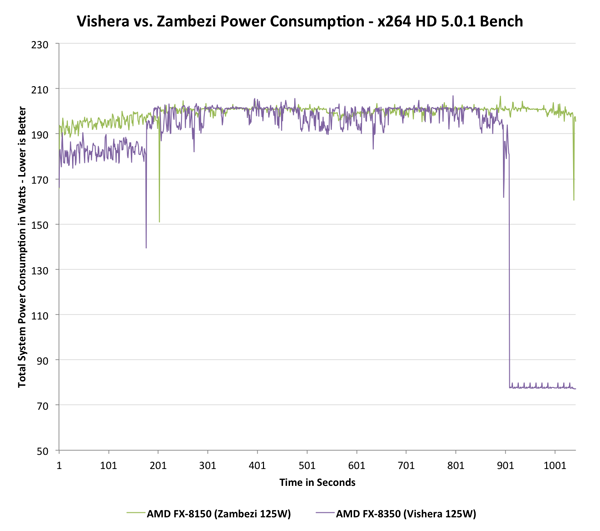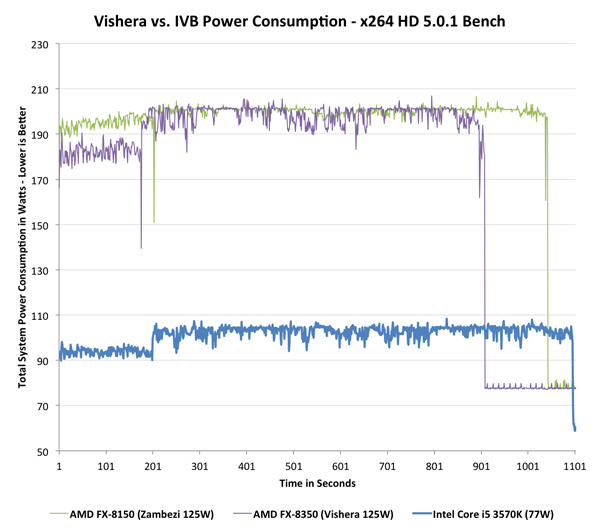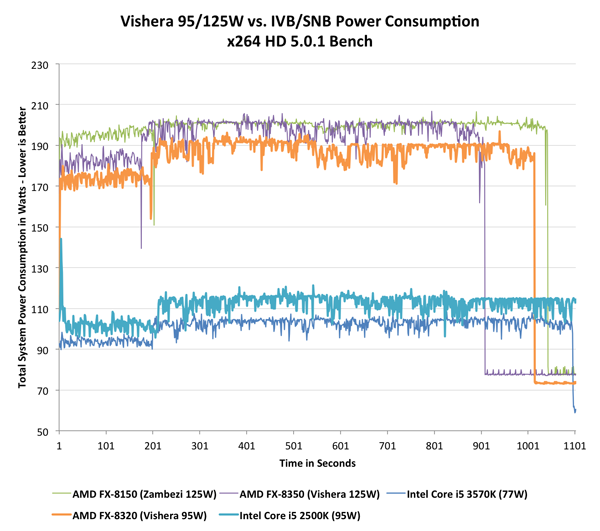The Vishera Review: AMD FX-8350, FX-8320, FX-6300 and FX-4300 Tested
by Anand Lal Shimpi on October 23, 2012 12:00 AM ESTPower Consumption
With Vishera, AMD was in a difficult position: it had to drive performance up without blowing through its 125W TDP. As the Piledriver cores were designed to do just that, Vishera benefitted. Remember that Piledriver was predominantly built to take this new architecture into mobile. I went through the details of what makes Piledriver different from its predecessor (Bulldozer) but at as far as power consumption is concerned, AMD moved to a different type of flip-flop in Piledriver that increased complexity on the design/timing end but decreased active power considerably. Basically, it made more work for AMD but resulted in a more power efficient chip without moving to a dramatically different architecture or new process node.
In mobile, AMD used these power saving gains to put Piledriver in mobile APUs, a place where Bulldozer never went. We saw this with Trinity, and surprisingly enough it managed to outperform the previous Llano generation APUs while improving battery life. On desktops however, AMD used the power savings offered by Piledriver to drive clock speeds up, thus increasing performance, without increasing power consumption. Since peak power didn't go up, overall power efficiency actually improves with Vishera over Zambezi. The chart below illustrates total system power consumption while running both passes of the x264 HD (5.0.1) benchmark to illustrate my point:
In the first pass Vishera actually draws a little less power, but once we get to the heavier second encode pass the two curves are mostly indistinguishable (Vishera still drops below Zambezi regularly). Vishera uses its extra frequency and IPC tweaks to complete the task sooner, and drive down to idle power levels, thus saving energy overall. The picture doesn't look as good though if we toss Ivy Bridge into the mix. Intel's 77W Core i5 3570K is targeted by AMD as the FX-8350's natural competitor. The 8350 is priced lower and actually outperforms the 3570K in this test, but it draws significantly more power:
The platforms aren't entirely comparable, but Intel maintains a huge power advantage over AMD. With the move to 22nm, Intel dropped power consumption over an already more power efficient Sandy Bridge CPU at 32nm. While Intel drove power consumption lower, AMD kept it constant and drove performance higher. Even if we look at the FX-8320 and toss Sandy Bridge into the mix, the situation doesn't change dramatically:
Sandy Bridge obviously consumes more than Ivy Bridge, but the gap between a Vishera and any of the two Intel platforms is significant. As I mentioned earlier however, this particular test runs quicker on Vishera however the test would have to be much longer in order to really give AMD the overall efficiency advantage.
If we look at average power over the course of the two x264 encode passes, the results back up what we've seen above:

As more client PCs move towards smaller form factors, power consumption may become just as important as the single threaded performance gap. For those building in large cases this shouldn't be a problem, but for small form factor systems you'll want to go Ivy Bridge.
Note that idle power consumption can be competitive, but will obviously vary depending on the motherboard used (the Crosshair Formula V is hardly the lowest power AM3+ board available):














250 Comments
View All Comments
A5 - Tuesday, October 23, 2012 - link
The gaming benchmarks contain exactly 0 FPS games. You should really read the article before commenting.kevith - Tuesday, October 23, 2012 - link
I could eat a dictionary and SHIT a better comment than that.CeriseCogburn - Tuesday, October 30, 2012 - link
" The FX-8350 did immensely better in that gaming selection. Mostl gamers are not shoot-em-up fascist gamers. "LOL - wrong again, but your lefty whine was extremely amusing. Most gamers are shoot em up gamers, YOU LIAR.
GullLars - Tuesday, October 23, 2012 - link
What they didn't show you is what happens when you OC the K parts from intel. They end up roughly in the same TDP as AMD on stock, and just crush them on performance, so if you are going to use the same aftermarket cooler and will overclock either pick, the Intel parts can go further and win across the board.Compared to the cost of an entire system ~$100-150 extra on the CPU for a 3770K might end up being around a 10% increase in total build cost, and giving you anywhere from 10 to 50% better performance (or more in some corner cases).
I'm happy with my OC'd 3930K :D (compared to to the rest of my equipment, the price was no problem)
Probably upgrading my C2D 2.0GHz + 8600GTM laptop to a Haswell with only IGP in 2013. With an SSD and RAM upgrade it has had surprisingly good longevity.
CeriseCogburn - Tuesday, October 30, 2012 - link
Exactly, all the amd cpu unlockers, all the dang phenom 2 overlcockers - totally silent.The 2500K smoke sit up to 4500mhz like butter, but heck, when something is freaking GREAT and it's not in amd's advantage, it's memory hole time, it's ignore it completely after barely mentioning it, and just as often continue to declare it an unused and unliked and proprietary failure that holds everyone back - whatever can be done to lie and skew and spin.
It's just amazing isn't it.
eanazag - Tuesday, October 23, 2012 - link
I had pretty low expectations admittedly and for good reason. This is a great step because I would have to think platform vs. platform where before I didn't even need to consider it. Intel has a huge thermal advantage, which indicates that Intel could easily come out with a proc at anytime to take advantage of that headroom should AMD ever become slightly threatening, and sadly still be below performance per Watt. I could reasonably consider AMD now for my desktop. Where AMD fails is at the platform level. They have underperformed in the motherboard department. If they wanted to sell more, they need to give serious advantages at the motherboard + CPU purchase level versus Intel. They have been fine with a mediocre chipset. They failed when they locked out Nvidia from chipset development, same with Intel. AMD and Intel's greed was a big loss for the consumer and part of the reason why AMD doesn't compete well with Intel. Nvidia made better chipsets for AMD than AMDs ATI chipset development team.It is even worse on the server side for AMD. AMD needs to include 10GbE on the board to really question Intel and this is doable. AMD cannot compete on process (22nm and 3D transistors) unless Intel closed shop for 18 months.
CeriseCogburn - Tuesday, October 30, 2012 - link
LOL - thank you so much.Yes, the hatred for nVidia (and Intel) cost the amd fanboys dearly, but they really, really, really enjoyed it when nVidia chipsets got shut down.
nVidia was going to be destroyed then shortly thereafter according to them, and thus we heard a couple years of it from their freaking pieholes - amd would drop the price and knife nVidia into oblivion... and bankrupcty... cause amd has a "lot more room" to price drop and still rake in profit... they said... LOL - as they whined about nVidia being greedy and making so much money.
Yes, they were, and are, nutso.
Oh the party days they had... now they have CRAP. LOL
Ken g6 - Tuesday, October 23, 2012 - link
Anand, I think you missed a diamond in the rough here for gaming. Obviously, if someone has the money for an i5, they should get an i5. But if they don't, the FX-4300 looks like a better gaming choice than an i3. There are cheap mobos available, so overall cost is less than an i3, and the FX-4300 is overclockable. OCed it may even approach low-end i5 performance - at a power cost, of course.tekphnx - Tuesday, October 23, 2012 - link
For only $10 more I'd say the FX-6300 is the better bet. Slightly lower clock speed but still overclockable, and I don't think it will be that long before six cores become really relevant for gaming.lmcd - Tuesday, October 23, 2012 - link
Worst case you can probably disable a core and OC more, right?